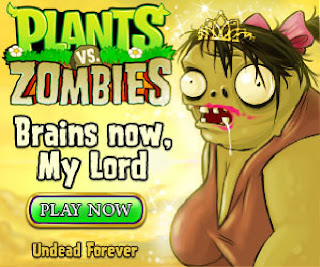 Gameplay
Gameplay
In Plants vs. Zombies, players place different types of plants and fungi, each with their own unique offensive or defensive capabilities, around a house in order to stop a horde of zombies from devouring the brains of the residents. The playing field is divided into a number of horizontal "lanes", and with rare exceptions, a zombie will only move towards the player's house along one lane (the main exception is if it has scented a garlic). Most plants can only attack or defend against zombies in the lane they are planted in. In the game's initial levels, if the zombie reaches the player's house, a one-shot tool (a lawn mower) can be used to completely wipe out zombies in that lane, but the tool will not be restored until the next level. In later levels, players have to purchase upgrades so as to adapt their lawn-mower to new environments like pools or rooftops. Except in special cases, Zombies attempt to devour any plants in their way while heading towards the house.
The player starts with a limited number of seed pack types and seed pack slots that they can use during most levels. New seed packs are gained by completing levels, while the number of slots can be increased through purchases with in-game money. At the start of a level, the player is shown the various types of zombies to expect and given the opportunity to select which seed packs to take into the level. In order to plant a seed, the player must have collected a specific amount of sunlight. Sunlight is generated by special plants which provide sunlight at regular intervals, or is automatically generated regularly for the player in very small amounts during daytime. Seed packs also have a short time delay (Or, in some cases, long) before the same seed can be planted again. Several plants are nocturnal, like mushrooms, having a lower sunlight cost and are ideal for nighttime levels, but will remain asleep during daytime levels unless awoken by a coffee bean. In the "backyard" levels that include a swimming pool, seeds must be planted atop lily pads on water spaces, while on the roof levels, all seeds must be planted in flower pots. The various plant abilities include firing projectiles at zombies, turning zombies against each other, quickly exploding and wiping out an area of zombies, and slowing down zombies. Certain plants are highly effective against specific types of zombies, such as a "Magnet-shroom" that can remove metallic items from a zombie, such as helmets and ladders.
The zombies also come in a number of types that have different attributes, in particular, speed, damage tolerance, and abilities. As the player progresses in the game, the zombies will include those wearing makeshift armour, those that are able to jump or fly over plants, and even a dancing "Michael Jackson" zombie (which was replaced with a generic "disco dancer zombie" as of the GOTY edition) that is able to summon other zombies from the ground. In each level, zombies will approach the house randomly. At special points where the player will be inundated with a huge wave of zombies; a meter on screen shows an approximate timeline for the level so the player can prepare for these waves, as well as determine the general stage length.







